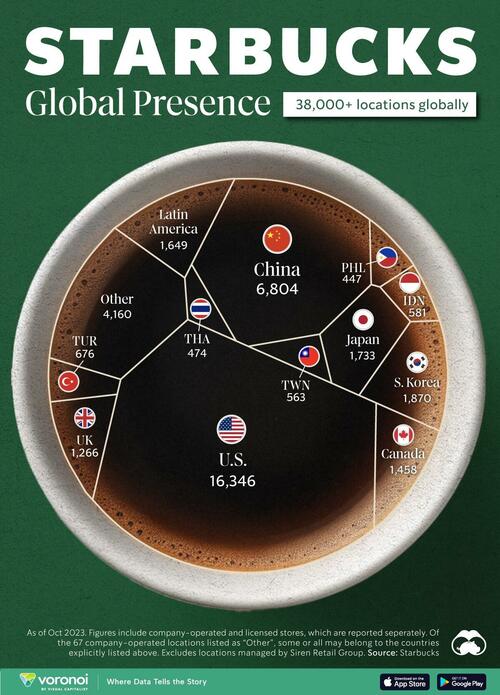Which Countries Have The Most Starbucks Stores?
Started in 1971 in Seattle, Washington, Starbucks is the second-most prolific quick-service brand in the United States.
Since then, Starbucks has spread to over 80 different countries in its mission to serve coffee (or another beverage of choice) to everyone who walks through their doors.
After all, that’s their primary revenue stream.
Note: This revenue mix is for company-operated stores only. Furthermore, “other” consists of sales of packaged and single-serve coffees and teas, serve-ware, and ready-to-drink beverages, among other items.
But which regions account for most of the coffee chain’s nearly 40,000 locations?
We visualize the number of Starbucks locations by country, as of October 2023, using data from their annual report from the 2023 fiscal year.
Ranked: Countries With the Most Starbucks Stores
Here’s a look at the number of Starbucks locations around the world, separated by ownership.
Note: Figures current as of October, 2023. Countries and regions labelled as identified by company annual filings. Of the 67 company-operated locations listed as “Other”, some or all may belong to the countries explicitly listed above. Excludes locations managed by Siren Retail Group.
The U.S. and China are easily Starbucks’ largest markets, accounting for more than 61% of all Starbucks locations, and also have the most stores under direct company control.
However, as Starbucks has pursued newer markets in Asia, it has increasingly relied on its licensing model to gain a foothold in the quick service segment.
The company’s primary focus is to open stores in high-traffic high visibility areas, like downtown cores in cities, but that hasn’t stopped it from venturing out into rural countrysides, relying on highway-adjacent lots to entice a potential customer looking for a quick brew.
Starbucks Revenue Model: Company-Owned Versus Licensed
What does a licensing model do for Starbucks anyway?
Unlike McDonald’s, Starbucks has a more focused approach in its expansion. The company licenses its brand, proprietary products, and operational methods to third-party operators, with nearly a perfect 50/50 split between company-operated and licensed stores.
This means licensees don’t have the same degree of independence as other chains, and Starbucks has more control over the appearance of its stores, the menu, and other operational aspects.
In return, Starbucks receives royalties or a percentage of sales from its licensees.
Tyler Durden
Tue, 01/02/2024 – 02:45
via ZeroHedge News https://ift.tt/8L3FCIr Tyler Durden



